Witch
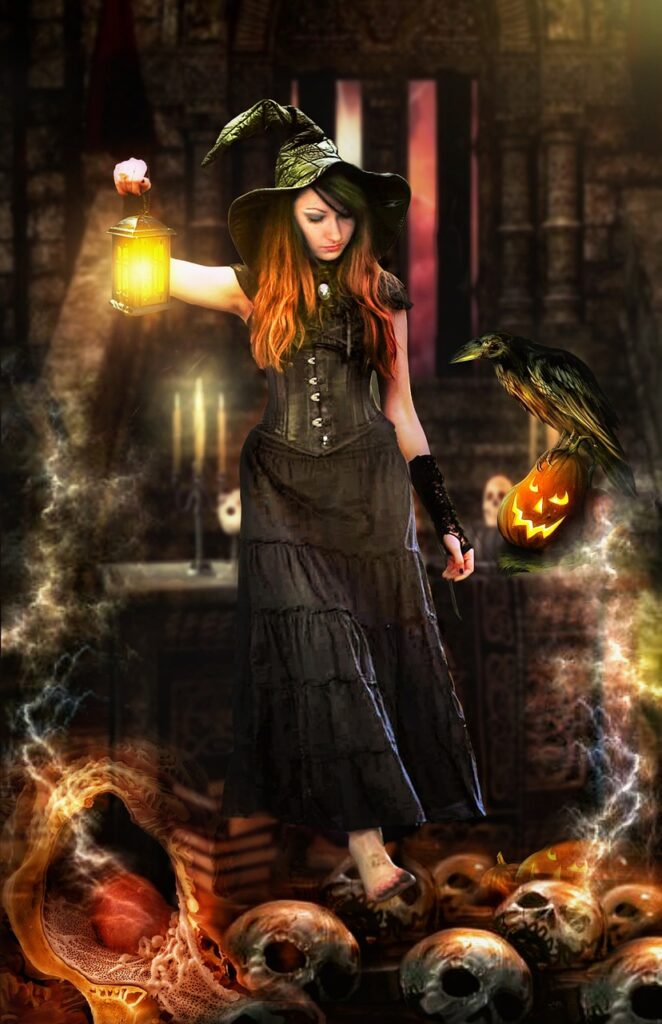
“There are more things in heaven and earth, Horatio, Than are dreamt of in your philosophy”.
Hamlet, Act 1, Scene 5
An old hag, a mysterious wise woman, cunning and alluring maiden… All of these and more are the guise of the witch. Witches have existed since the dawn of time and are some of the greatest of all of the spellcasters.
Liber Mysterium
The Netbook of Witches and Warlocks
By Timothy S. Brannan and The Netbook of Witches and Warlocks Team
With elements originally Posted by
Shadowfoot of the Wizards Community forums.
Introduction to witches
Game Rule Information
Witches have the following game statistics
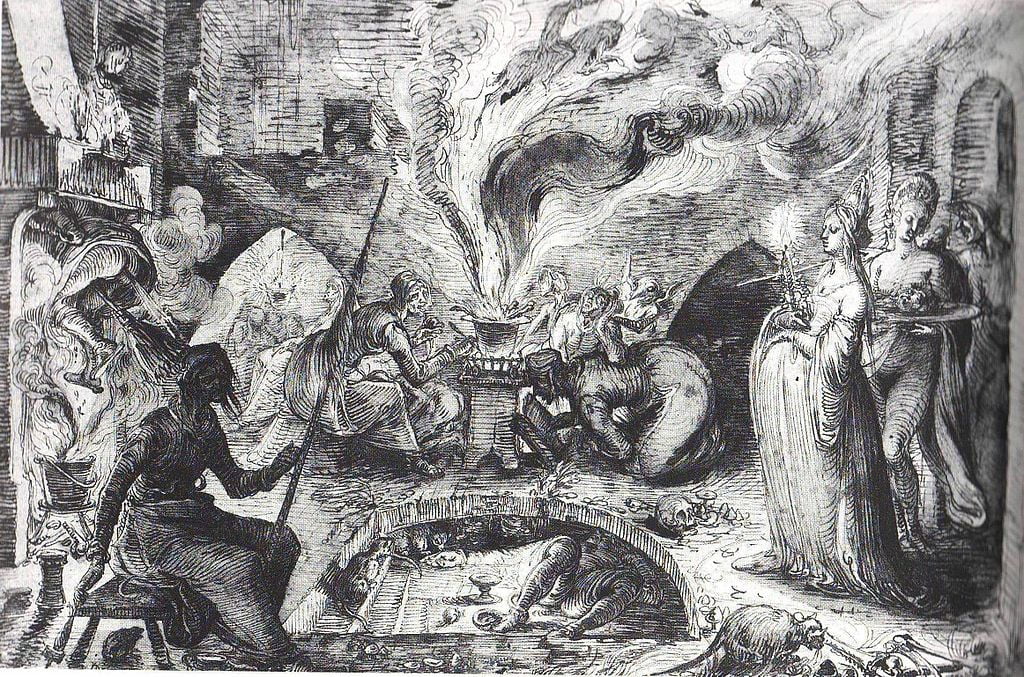
Abilities:Wisdom determines how powerful the spells the witch can cast, how many spells they may cast per day, and how hard those spells are to resist.
Like clerics and druids, the witch must have a minimum Wisdom score of 10 + the spell’s level and gains bonus spells based on her Wisdom.
The Difficulty Class (DC) of a saving throw against a witch’s spell is 10 + the spell’s level + the witch’s Wisdom modifier. Intelligence and Charisma are also important to the witch character.
Alignment: Any, but the witch’s alignment must be similar (by one step) to their Patron’s alignment.
Hit Die: d4
Class Skills
The witchs class skills (and the key ability for each skill) are Alchemy (Intelligence)1,Bluff (Charisma), Concentration (Constitution), Craft (Wisdom), Heal (Wisdom), Knowledge (Arcana) (Intelligence), Knowledge (Demonology) (Intelligence), Knowledge (Nature) (Intelligence), Knowledge (Religion) (Intelligence), Knowledge (Witchcraft) (Intelligence), Meditative Trance, Profession (Fortune Teller) (Wisdom), Profession (Herbalist) (Wisdom), Profession (Midwifery) (Wisdom), Scry (Intelligence)2, Seduction (Charisma), Sense Motive (Wisdom), Spellcraft (Intelligence), Survival (Wisdom) [Wilderness Lore (Wisdom)], Tantra (Charisma), Yoga (Wisdom).
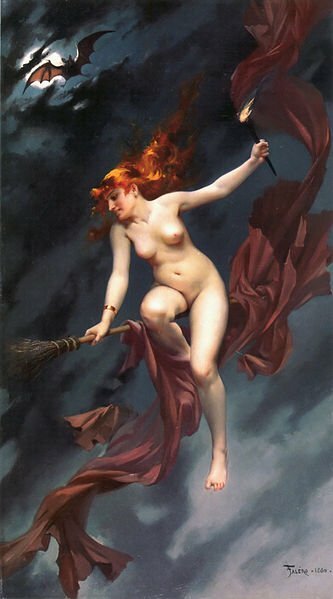
Skill Points at 1st Level: (2 + Intelligence modifier) x 4. Skill Points at Each Additional Level: 2 + Intelligence modifier.
| The Witch | |||||
| Level | Base Attack Bonus | Fort Save | Ref Save | Will Save | Special |
| 1 | 0 | +0 | +0 | +2 | Create Talisman, Dabble, Familiar, Vulnerability |
| 2 | +1 | +0 | +0 | +3 | Summon Familiar |
| 3 | +1 | +1 | +1 | +3 | Brew Potion |
| 4 | +2 | +1 | +1 | +4 | Bonus Feat |
| 5 | +2 | +1 | +1 | +4 | Trackless Step |
| 6 | +3 | +2 | +2 | +5 | Bewitch |
| 7 | +3 | +2 | +2 | +5 | Occult Power |
| 8 | +4 | +2 | +2 | +6 | Hex |
| 9 | +4 | +3 | +3 | +6 | |
| 10 | +5 | +3 | +3 | +7 | Dabble |
| 11 | +5 | +3 | +3 | +7 | |
| 12 | +6/+1 | +4 | +4 | +8 | Bewitch |
| 13 | +6/+1 | +4 | +4 | +8 | Occult Power |
| 14 | +7/+2 | +4 | +4 | +9 | Coven |
| 15 | +7/+2 | +5 | +5 | +9 | Hex |
| 16 | +8/+3 | +5 | +5 | +10 | Bonus Feat |
| 17 | +8/+3 | +5 | +5 | +10 | |
| 18 | +9/+4 | +6 | +6 | +11 | Bewitch |
| 19 | +9/+4 | +6 | +6 | +11 | Occult Power |
| 20 | +10/+5 | +6 | +6 | +12 | Dabble, Ageless |
| Witch Spells per Level | ||||||||||
| Spells Per Day | ||||||||||
| Level | 0 | 1 | 2 | 3 | 4 | 5 | 6 | 7 | 8 | 9 |
| 1 | 3 | 1 | – | – | – | – | – | – | – | – |
| 2 | 4 | 1+1 | – | – | – | – | – | – | – | – |
| 3 | 4 | 2+1 | 1 | – | – | – | – | – | – | – |
| 4 | 5 | 2+1 | 1+1 | – | – | – | – | – | – | – |
| 5 | 5 | 3+1 | 2+1 | 1 | – | – | – | – | – | – |
| 6 | 5 | 3+1 | 2+1 | 1+1 | – | – | – | – | – | – |
| 7 | 6 | 3+1 | 3+1 | 2+1 | 1 | – | – | – | – | – |
| 8 | 6 | 4+1 | 3+1 | 2+1 | 1+1 | – | – | – | – | – |
| 9 | 6 | 4+1 | 3+1 | 3+1 | 2+1 | 1 | – | – | – | – |
| 10 | 6 | 4+1 | 4+1 | 3+1 | 2+1 | 1+1 | – | – | – | – |
| 11 | 6 | 4+1 | 4+1 | 3+1 | 3+1 | 2+1 | 1 | – | – | – |
| 12 | 6 | 5+1 | 4+1 | 4+1 | 3+1 | 2+1 | 1+1 | – | – | – |
| 13 | 6 | 5+1 | 4+1 | 4+1 | 3+1 | 3+1 | 2+1 | 1 | – | – |
| 14 | 6 | 5+1 | 5+1 | 4+1 | 4+1 | 3+1 | 2+1 | 1+1 | – | – |
| 15 | 6 | 5+1 | 5+1 | 4+1 | 4+1 | 3+1 | 3+1 | 2+1 | 1 | – |
| 16 | 6 | 5+1 | 5+1 | 5+1 | 4+1 | 4+1 | 3+1 | 2+1 | 1+1 | – |
| 17 | 6 | 5+1 | 5+1 | 5+1 | 4+1 | 4+1 | 3+1 | 3+1 | 2+1 | 1 |
| 18 | 6 | 5+1 | 5+1 | 5+1 | 5+1 | 4+1 | 4+1 | 3+1 | 2+1 | 1+1 |
| 19 | 6 | 5+1 | 5+1 | 5+1 | 5+1 | 4+1 | 4+1 | 3+1 | 3+1 | 2+1 |
| 20 | 6 | 5+1 | 5+1 | 5+1 | 5+1 | 5+1 | 4+1 | 4+1 | 3+1 | 3+1 |
| The number after the plus sign (+) is the number of C ven (divine) Spells the witch receives. |
Witch
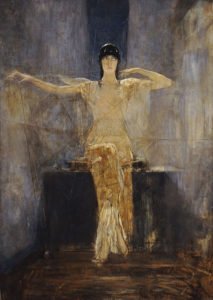
1884
Witches are spellcasters that walk the line between this world and the next, between angel and fiend, and between clerics and wizards. They are a religious sect like clerics, but closer to druids. Their spells and casting techniques are similar to wizards. Despite stereotypes, witches may be either female or male; there are typically more female witches than there are male witches. Contrary to popular belief -warlock- is not the masculine form of witch. Witches, whether male or female, are referred to as witches. Warlock is a word meaning peace-breaker or oath breaker, and is considered to be a vulgar insult to a witch.
Mistresses of haunted forests, healers on the outskirts of town, crones creeping through crypts, or that unusually charming maiden: witches come in all shapes and dispositions, but they are often objects of mystery and suspicion in most cultures, even hated and persecuted.
Like sorcerers, witches are born with their aptitude for charms, trickery, and nature magic – often from the union of an ancestor and a Fey, Lycanthrope, or outsider. Witches can also draw upon other sources of arcane inspiration, such as symbols, icons, and certain creatures, by dabbling in arcane Arts.
Adaptation: The witch represents the fantasy archetype distinct from a simple wizard or sorcerer, and far less specific than a druid. It can replace the sorcerer as a more flavorful alternative, using Tradition and Dabble to represent bloodlines and giving the witch a more distinct flavor than the standard class adequately accommodates.
Adventures: Witches on the whole tend not to be adventurers. Many have terrifying memories of what some people will do to witches; others feel a close association to their homeland, their families or their covens. There are others though for whom the lure of adventuring is too much to ignore. Witches that adventure do so for a variety of reasons. Many are searching for greater magical or universal truths, or to recover a special artefact or spell component. A small number seek, like many adventurers, fame and fortune. Still others desire to be away from the closed minds of their homelands and search for others like themselves. And some seek things known only to themselves and their Patron.
Characteristics: Witches cast arcane spells, as do wizards and sorcerers; they also gain some ability to cast divine spells. Both types of spells are gained from the witch’s service to their Patrons. Witches record their spells in spell-books (sometimes known as a Book of Shadows) like wizards. Like shadows that are neither all dark nor all light, witches are neither all cleric nor all wizard, but a bit of both, and something else altogether.
Witches also tend to avoid weapons and armour because their nature is one of magic, pure and untainted. Armour would also interfere with their spell casting abilities.
Alignment: Despite stereotype and rumour, witches can be of any alignment. Many witches believe in The Three-fold Law, that is whatever you send out into the world, will return upon you three times. So a witch is often reluctant to cast so called -black- or evil magic.
Religion: To a witch, to worship is to be a witch. Unlike clerics, who commune to their gods for the people, there is no middle ground between the Patrons and their witches. Also unlike clerics, witches, even evil ones, do not attempt to convert others to their faith. Witches believe one must be worthy and hear the Call.
Non-witches often misunderstand the practice of witchcraft; this is one of many factors that have lead to distrust of witches.
Witches honour and follow their Patrons, the God and Goddess of their faith. Many witches believe there is only a single Goddess, and all deities are simply different aspects of the Goddess. The name of the goddess may change between planes, but names are only reflections of the Goddess.
Examples of the witches- Goddesses include Astartë, Hecate, Diana, Isis, Innana, or even Tiamat, but can include any Goddess from the witch’s home world.
Other witches believe that there are two deities, a male and a female, a God and a Goddess. The male is considered the Bringer of Summer, the Lord of Harvest and Protector of the Goddess. Real world examples include Apollo, Bacchus, Cernunnos, Osiris, or Shiva. Both God and Goddess are considered equal in all respects.
The system of belief can change between each campaign world and plane. However, it is commonly these two systems, or a combination of these two that witches across the multiverse practice. It is also this philosophy that leads to the rift between clerics and witches.
Other witches gain their powers from other worldly beings, fiends from the lower planes, creatures from the Astral, or Spirits they take as their Patron. Hedge witches are spellcasters that follow the witches· practice, but not their religion.
Magic: Witches are primarily arcane spellcasters, though they say their magic is older than the distinctions of -Arcane- and -Divine-.
Witches learn their magic from their Patron. They may do this via meditation, ritual or even via their familiar. Once the knowledge of a spell is given to the witch she copies the spell into her spell book (-Book of Shadows-). Once this is done she may relearn that spell at any time, as does a wizard. The witch may also research spells, as does a wizard. These spells are also recorded in their Books of Shadows.
The witch also gains the ability to cast special spells known as Coven Spells. These spells are known to the witch and her coven and are usually divine in nature, the exact spells varying from coven to coven and Patron to Patron.
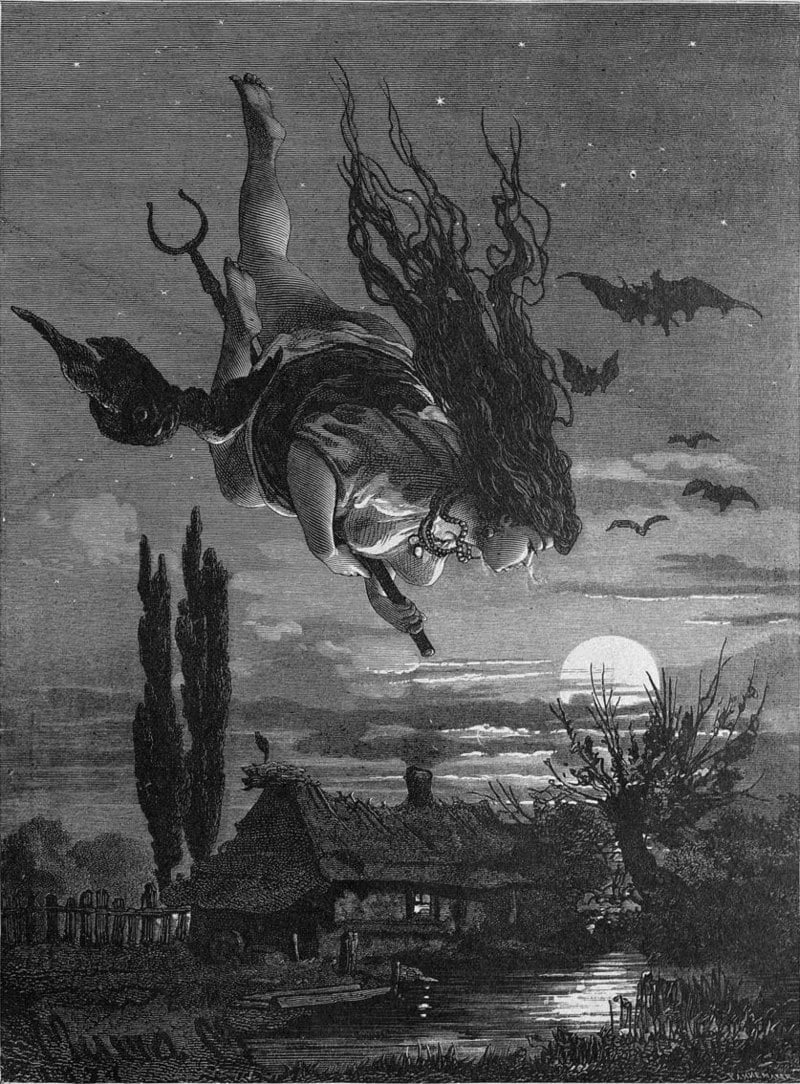
The power to cast the spells is given by the Patron, but formed by the witch. In this respect they are very similar to Divine spellcasters. While a cleric prays for her spells, a witch prepares them through ritual.
These acts might seem similar at first, but they are different. A cleric’s prayer is somewhat comparable to asking a patron kindly if they’ll grant them this power. A witch’s ritual on the other hand is comparable to the spell casting of a wizard, interlaced with religious elements.
Background: To become a witch, one must first hear “the Call”. This is the moment in the would-be witch’s life that she understands that she will become a witch. Sometimes the Call is symbolic, such as sudden realization after many days, weeks or months of conjecture; other times it is happenstance, the would-be witch finds an old book or a teacher; and still other times the Call is actual, the initiate actually hears the voice of their Patron calling out to them. In many Traditions this is also known as the “Call of the Goddess”. This usually precludes any other type of training for any other profession since many witches receive this call at an early age, as children or teenagers.
All witches belong to a Tradition (defined as a style of witchcraft) and a Coven (meaning groups of worship). A witch that does not belong to a geographic Tradition is said to have a Family Tradition because it is usually passed down from mother to daughter, or an Eclectic Tradition, one that has the features of many traditions. A witch without a coven is often known as a “Solitary Practioner”.
Witches learn to be witches from laws and guidelines handed down from the Patron and practiced within the covens. Solitaries often must learn the craft on their own.
- Amazon
- Chovihani
- Craft of the Wise
- Eclectic Witch
- Faerie Tradition
- Family Tradition
- Lorelei
- Malefic
- Tantric
- Tempestarii
- Venefica
- Voodoo
Races: Humans make up the majority of the witches. Elves and half-elves also have a style of witchcraft known as – kuruni -. Half-orcs are generally drawn to the evil side of witchcraft. Dwarves, Gnomes and Halflings only rarely, become witches, but each has their own unique style.
Other Classes: Witches tend to share with druids and rangers a reverence for the world and nature. Also like druidism, witchcraft is an older religion. Witches and druids sometimes argue over which religion came first, but these are usually only good-natured, if sometimes heated debates. Most classes distrust witches. In particular witches do not get along with clerics, whom they find to haughty in their ideals and
reverence to their gods, and likewise with paladins (plus most Witch-Hunters tend to come from the ranks of clerics and paladins).
Witches are often viewed with caution, if not out-right hatred by clerics and paladins, who find the witch’s belief that individual deities are in reality different aspects of a single deity blasphemous. The average person also finds the witch’s magic to be mysterious and dangerous, and if the witch is perceived as dangerous, she must be dealt with. Though the accusation of -witch- can and has applied to witches, wizards,
sorcerers, other clerics and psionics.
Witches and clerics share more similarities than either side would like to admit. This is due to a split in ethos among the pre-historic peoples. An ancient protoshamanistic cult produced both witches and druids. This proto-cult then further splintered into witches, druids and priests of today. Witches therefore share many surface similarities with druids and shamans. Many neutral witches are, in fact, on fairly good terms with most druids.
Although a witch is partially a divine spellcaster, the function of a cleric and a witch is very different. Witches do not serve their Patron as a cleric serves their god. A witch is the instrument of their Patron’s will, and the Patron serves the witch via magic. There is a direct personal relationship between a witch and her Patron. In simple terms, a cleric sees herself as a servant to her deity, while a witch sees her deity as a friend. This of course, is a simple definition.
A witch does not see it as her duty to spread the beliefs of her patron, her duty is to live by her Patron’s rules and ethics, not to convince others to do so, as would a cleric.
Witches are on decent terms with sorcerers, whom they find more tolerable than wizards. They are distrusted by barbarians, who distrust all magic, viewed suspiciously by most rogues, who are suspicious of most people, and mostly ignored by monks. Some witch traditions get along well with bards, but the differences within either class make this a case-by-case judgment.
Multiclass: Witches may multiclass without restriction, however nearly all witches begin as witches and not another class. Witches also consider themselves to be witches first and foremost.
Class Features
All of the following are class features of the witch.
Weapon and Armor Proficiency: Witches are proficient with all simple weapons.
Spells: Witches gain 2 new arcane spells at each level, just like wizards. They may also copy spells from other witches just as a wizard
may copy spells from another wizard, The witch’s and wizard‘s spell casting are related but still very different, and therefore a witch can
attempt to learn a wizard’s spell book or scroll with a -5 penalty (and vice versa). The penalty to learn witch spells by a wizard
is -5 and plus -1 per witch spell level to all checks, thus a 6th level witch spell would be at -11 to learn. Ranks in Knowledge
(Witchcraft) will reduce this by one per rank.
The witch is limited to casting spells that appear in her spell book. Unlike a wizards spell book, Witch spells do not cost money or materials (outside of the paper and ink) to scribe into a spell book. Witch spells are cast via a series of rituals and preparation, typically performed in the morning or night before, and completed when the witch wishes to cast her spell.
A witch must prepare her spells ahead of time, just like a wizard. In the same way all bard spells have verbal components, all witch spells have material components or a focus. Spells that do not list material components instead require a common object sacred to or indicative of the witch’s Patron as a focus.
The witch can cast arcane spells as per the table below. Also, witches gain the ability to cast some divine spells. These divine spells are known as Coven spells and are determined by the coven that the witch belongs to. The divine spells that a witch may cast are also described below.
Note: Witch cantrips are known as Charms if used by good witches, Leys if used by neutral witches and Hexes if used by evil witches. Common people refer to all witch cantrips as Hexes.
Chaotic, Evil, Good, and Lawful spells: A witch cannot cast spells of an alignment opposed to her own or her Patron. This is similar to the cleric’s limitation. Witches also have spells that are unique to their own class
Coven Spells: Witches gain an additional spell of each spell level starting at 2nd level (indicated by the +1 on table 1-2). These are known as Coven spells and are determined by the Patron of each witches coven. Coven spells function similar to domain spells with the exception that the witch’s Coven spells do not grant the special abilities that a cleric would receive from a domain (for example, the luck domain allows one die re-roll once per day, a witch with a Patron of the luck domain does not receive this ability).
A witch’s Coven or Patron determines what she may choose for her Coven spells.
For example, a Faerie Witch (a witch specializing in the magical nature of forests) may choose Coven spells from among those granted by the Plant, Animal or Travel Domains. Coven spells are considered divine. Unlike the witches· normal spells, these spells are cast in the same way a cleric casts domain spells.
Familiar: The witch is often accompanied by a peculiar animal familiar, such as a black cat, warty toad, or owl. Attracting her familiar takes one day and uses up magical materials that cost 100gp. If selected at 1st level, some Arts, such as Cat Magic, dictate the type of familiar received.
The witch can enhance Familiar with the Blood Art and Sorcerous feats.
Summon Familiar: A witch can summon a familiar in exactly the same manner as a sorcerer or wizard.
Bonus feats: The witch gains a bonus feat every 6 levels, starting at 4th level (4th, 10th, and 16th). The witch may choose any Item Creation, Metamagic or Witch feat she has met the requirements for.
The witch has access to a special group of feats known as Witch feats. These feats are unique to the witch class, but other classes may learn some of these (at the GM’s discretion).
The witch also gains a bonus feat at 1st level. This feat may be any feat the witch has met the requirements for.
Occult Powers: Witches gain special abilities at 7th, 13th, and 19th levels. These special abilities are determined by the witch’s Tradition (or by the Game Master)
Dabble [1st/10th/20th level]: Each witch has a natural affinity for one of the forbidden, secret, or obscure branches of witchcraft called the Arts. Dabbling in a particular Art can merely reflect the witch’s own personal preference or hint at some magical heredity. A witch descended from a humanoid and Fey union may naturally have a knack for Fairy Magic, for example, while one from a humanoid and Weretiger coupling may dabble in Cat Magic, Moon Magic, or both. At the indicated levels, she selects an Art in which to dabble that corresponds with her alignment. She gains the indicated power and adds the listed spells to her list of Spells Known.
The known arcane Arts include:
- Dabble Astrology
- Dabble Black Magic
- Dabble Brimstone
- Dabble Candles
- Dabble Cat Magic
- Dabble Cauldrons:
- Dabble Crystals:
- Dabble Curses:
- Dabble Demonology:
- Dabble Dreams:
- Dabble Fairy Magic:
- Dabble Folk Magic:
- Dabble Gaze Magic:
- Dabble Incantations:
- Dabble Mirrors:
- Dabble Mist Magic:
- Dabble Moon Magic:
- Dabble Numerology:
- Dabble Pentacles:
- Dabble Prophecy:
- Dabble Secrets:
- Dabble Seduction:
- Dabble Seduction:
- Dabble Serpent Magic:
- Dabble Songs:
- Dabble Spider Magic:
- Dabble Spiritism:
- Dabble Swamp Magic:
- Dabble Toadstools:
- Dabble Weather Magic:
- Dabble White Magic:
- Dabble Winter Magic:
The witch can Dabble in a maximum number of Arts equal to her Charisma modifier -1. If she selects an Art that includes a witch spell she already knows, she can instead select any witch spell of equal level. Should she change alignment to one that violates a chosen Art’s restriction, she loses the granted power and access to the related spells. Once her alignment again agrees with her Art, her power and spell access return.
The witch can enhance Dabble with the Art Focus, Blood Art, Dabble, and Extra Witch Ability feats.
Vulnerability: All witches harbor some secret weakness or undiscovered vulnerability, the result of the peculiar magic that flows within them. The witch acquires a vulnerability, determined randomly from the following list (or one approved by the DM):
- Coldiron: cold iron weapons strike the witch as if the wielder has the Improved critical feat (if the wielder has the Improved critical feat, the threat range is only increased by 1). A critical hit forces her to make Fortitude save (DC equal to the damage dealt) or be nauseated for 1 round. Any cold iron damage can only be healed with magic.
- Fire: She is especially vulnerable to fire. Fire spells and effects do an additional +1 point of damage per die to the witch, and any damage inflicted can only be healed by magic.
- Marked: The witch has a deformity that clearly separates her from others of her race, such as green skin, a long warty nose, a large hump, or cloven feet. She does not receive her Charisma bonus to Diplomacy, Disguise, Gather Information, and Handle Animal checks and instead receives a penalty to those checks equal to half of her Charisma bonus (rounded up). Animals always regard the witch with hostility.
- Pact: The witch is schooled in magic by a more powerful being, such as a celestial, dragon, fiend, or spirit of the land – but at a price. Before being allowed access to spells of a higher spell level, the witch must strike a bargain with her patron, such as agreeing to perform some deed or making some sacrifice. The nature and difficulty of the bargain depends upon both the disposition of the patron and the capability of the witch. If she fails to complete the given bargain, she suffers a -10% penalty to all earned experience points, which stacks with any multiclassing penalties, until she attains another level of witch granting spellcasting and fulfills the next bargain.
- Pagan: Her pagan nature leaves the witch vulnerable to both Holy Water and unholy water. Splash from either liquid inflicts 2d4 points of acid damage upon the witch, which can only be healed with magic. In addition, if she consumes food or water created by divine magic, such as from the create food and water spell, she must make a Fortitude save (DC 10) or be nauseated for 1 hour.
- Silver: Silver weapons strike the witch as if the wielder has the Improved critical feat (if the wielder has the Improved critical feat, the threat range is only increased by 1). A critical hit forces her to make Fortitude save (DC equal to the damage dealt) or be nauseated for 1 round. Any silver damage can only be healed with magic.
The witch can enhance Vulnerability with the Hag Claws feat.
Brew Potion [3rd level]: With a bubbling cauldron, the witch can concoct a variety or elixirs and potions. She receives the Brew Potion feat for free.
Trackless Step [5th level]: Creeping through woods, the witch is like a mist passing through shadows. She leaves no trail in natural surroundings and cannot be tracked. This is extraordinary.
Bewitch [6th/12th/18th level]: By merely uttering a few seductive words, the witch can bewitch another creature with charm person. If the witch delivers Bewitch as a touch attack, the DC is increased +2. This spell-like ability can be used once per day for every six levels of witch.
The witch can enhance Bewitch with the Charm a Crowd, Cupid’s Brew, Extra Witch Ability, Greater Charm, Subschool Focus, and Touch Focus feats.
Hex [8th/15th level]: By uttering a few carefully chosen words – sometimes poetic, often vulgar – the witch can hex any creature within 30 feet as if she had cast a ranged version of bestow curse. If the witch delivers the Hex as a touch attack, the DC increases +2. This spell-like ability can be used once per day for every seven levels of witch.
The witch can enhance Hex with the Extra Witch Ability, Greater Curse, and Touch Focus feats.
Coven [14th level]: A witch of sufficient power and renown attracts lesser witches, her seek her out for instruction and protection. The witch is considered to have the Leadership feat for the purposes of attracting witches and warlocks as followers. If she already has the Leadership feat, her effective level is considered +2 for the purposes of attracting other witches.
In addition, witches gain power in numbers. When at least seven ally witches are within a 30-foot radius area, with no two witches more than 30 feet apart, each witch enjoys a +1 morale bonus to the DC of all witch spells they cast. When 13 witches congregate, they enjoys a +2 morale bonus to the DC of all witch spells they cast. This is extraordinary.
Ageless [20th level]: She is forever young. The witch no longer suffers ability penalties for aging and cannot be magically aged; bonuses are still accrued, and she still dies of old age when her time it up. This is extraordinary.
- Witch Spell Lists
- Covencraft
- Covens and Game Play
- Witch’s Name
- Witch’s Mark
- Duties of the Coven
- Officers
Ex-Witches
Any
witch who ceases to follow her patron loses all coven (divine) spells, special
abilities and cannot gain levels as a witch until she atones. Use of the Atonement
spell is not required, but the witch may have to perform an act of faith.
Human
Witch Starting Package
Race: Human
Armour: None, speed 30 ft.
Weapons: Dagger (1d4, crit 19-20/x2, 1lb., Tiny, Piercing). quarterstaff (1d6, crit x2, 4lb., Large, Bludgeoning).
Patron(s): The Great Goddess and the Lord of Summer.
Skill Selection: Pick a number of skills equal to 4 + Intelligence modifier.
| Skill | Ranks | Ability |
| Spellcraft | 4 | Intelligence |
| Knowledge (Witchcraft) | 4 | Intelligence |
| Heal | 4 | Wisdom |
| Knowledge (Demonology) | 4 | Intelligence |
| Craft | 4 | Wisdom |
Feats: Astromancy, Create Talisman
Gear: Backpack with waterskin, one day’s trail rations, bedroll, sack, flint and steel, spell component pouch, Book of Shadows
Gold: Equal to Charisma score.
Alternate Witch Starting Package
Same as human witch, except
Race: Elf, half-elf, half-orc
Patron(s): As appropriate for Race.
Gold: 2d6
Alternate Witch Starting Package
Same as human witch, except
Race: Dwarf, gnome or halfling.
Armour: None, speed 20 ft.
Patron(s): As appropriate for Race.
Gold: 2d6
Epic Level Witch
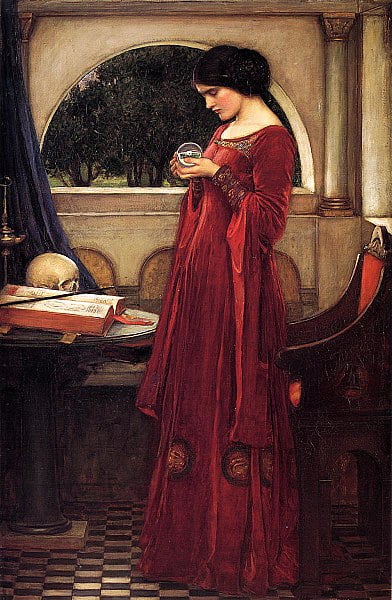
When a witch reaches 21st level she is considered to be an epic character. Epic characters are dealt with in Core Rulebook II, v.3.5. Briefly, the following applies
to witches beyond 20th level.
- Class-related base save bonuses and base attack bonus don’t increase after 20th level. Thus, these class tables have no columns for base save bonuses or base attack bonus. Instead, use Table: Epic Save and Epic Attack Bonuses (Core Rulebook II, v.3.5) to determine the character’s epic bonus on saving throws and attacks.
- A character continues to gain Hit Dice and skill points as normal beyond 20th level.
- Generally speaking, any class feature that uses the character’s class level as part of a mathematical formula continues to increase using the character’s
class level in the formula. - Any prestige class feature that calculates a save DC using the class level should add only half the character’s class levels above 10th.
- The powers of familiars, special mounts, and fiendish servants continue to increase as their masters gain levels, if they are based on a formula that includes the caster’s level.
- Any class features that increase or accumulate as part of a repeated pattern also continue to increase or accumulate after 20th level at the same rate. An exception to this rule is any bonus feat progression granted as a class feature. If a character gets bonus feats as part of a class feature these do not increase with epic levels. Instead, these classes get a new bonus feat progression (described in each class summary below).
- A character doesn’t gain any new class features beyond 20th level. Class features with a progression that slows or stops before 20th level and features that have a limited list of options do not improve as a character attains epic level. Likewise, class features that are gained only at a single level do not improve.
The epic witch is a raw force of nature and the divine. Channeling the powers of her Patron, she is both respected and feared.
Hit Die: d4.
Skill Points at Each Additional Level: 4 + Intelligence modifier.
Spells: The witch’s caster level is equal to her class level. The witch’s number of spells per day does not increase after 20th level. Each time the witch attains a new level, she learns two new spells of any level or levels that she can cast (according to her new level).
Familiar: The epic witch’s familiar continues to increase in power. Every two levels higher than 20th the familiar’s natural armour bonus and Intelligence each increase by +1. The familiar’s Spell Resistance is equal to the master’s level + 5. At 21st level and again every ten levels higher than 21st, the familiar gains the benefit of the Familiar Spell epic feat for a spell of its master’s choice.
Bonus Feats: The epic witch gains a bonus feat every three levels higher than 20th. The witch also gains access to Epic feats.
Occult Powers: The epic witch does not gain any new occult powers but occult powers based on the witch’s level continue to grow.

 Buy me a coffee
Buy me a coffee